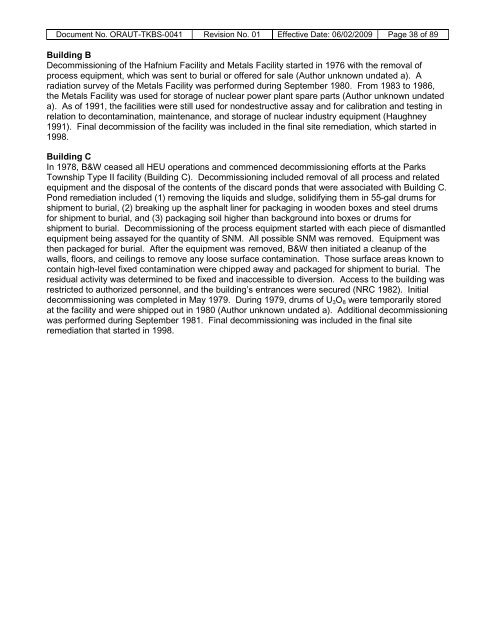ORAU TEAM Dose Reconstruction Project for NIOSH
ORAU TEAM Dose Reconstruction Project for NIOSH
ORAU TEAM Dose Reconstruction Project for NIOSH
You also want an ePaper? Increase the reach of your titles
YUMPU automatically turns print PDFs into web optimized ePapers that Google loves.
Document No. <strong>ORAU</strong>T-TKBS-0041 Revision No. 01 Effective Date: 06/02/2009 Page 38 of 89<br />
Building B<br />
Decommissioning of the Hafnium Facility and Metals Facility started in 1976 with the removal of<br />
process equipment, which was sent to burial or offered <strong>for</strong> sale (Author unknown undated a). A<br />
radiation survey of the Metals Facility was per<strong>for</strong>med during September 1980. From 1983 to 1986,<br />
the Metals Facility was used <strong>for</strong> storage of nuclear power plant spare parts (Author unknown undated<br />
a). As of 1991, the facilities were still used <strong>for</strong> nondestructive assay and <strong>for</strong> calibration and testing in<br />
relation to decontamination, maintenance, and storage of nuclear industry equipment (Haughney<br />
1991). Final decommission of the facility was included in the final site remediation, which started in<br />
1998.<br />
Building C<br />
In 1978, B&W ceased all HEU operations and commenced decommissioning ef<strong>for</strong>ts at the Parks<br />
Township Type II facility (Building C). Decommissioning included removal of all process and related<br />
equipment and the disposal of the contents of the discard ponds that were associated with Building C.<br />
Pond remediation included (1) removing the liquids and sludge, solidifying them in 55-gal drums <strong>for</strong><br />
shipment to burial, (2) breaking up the asphalt liner <strong>for</strong> packaging in wooden boxes and steel drums<br />
<strong>for</strong> shipment to burial, and (3) packaging soil higher than background into boxes or drums <strong>for</strong><br />
shipment to burial. Decommissioning of the process equipment started with each piece of dismantled<br />
equipment being assayed <strong>for</strong> the quantity of SNM. All possible SNM was removed. Equipment was<br />
then packaged <strong>for</strong> burial. After the equipment was removed, B&W then initiated a cleanup of the<br />
walls, floors, and ceilings to remove any loose surface contamination. Those surface areas known to<br />
contain high-level fixed contamination were chipped away and packaged <strong>for</strong> shipment to burial. The<br />
residual activity was determined to be fixed and inaccessible to diversion. Access to the building was<br />
restricted to authorized personnel, and the building’s entrances were secured (NRC 1982). Initial<br />
decommissioning was completed in May 1979. During 1979, drums of U3O8 were temporarily stored<br />
at the facility and were shipped out in 1980 (Author unknown undated a). Additional decommissioning<br />
was per<strong>for</strong>med during September 1981. Final decommissioning was included in the final site<br />
remediation that started in 1998.

















